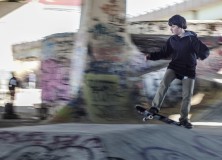Once again, cultural evolution, and the problem of memes: What are they? Where are they? What do they do? While the general case does interest me, culture is so various that it is impossible to think about it directly. One has to think about specific cases. As details are important, I want to choose a fairly specific case, that of jazz in mid-20th-Century America. I want you to imagine that you’re in a jazz club in, say, Philadelphia, in, say, mid-October of 1952. It’s 1:30 in the morning, and the tune is Charlie Parker’s “Dexterity.” The piano player counts it off–ah one, ah two, one two three four…
But we’re getting ahead of ourselves. We need a little conceptual equipment before considering the example. It’s the conceptual equipment that’s in question. Make no mistake, the concept of memes is conceptual equipment, and it’s confused and confusing.
Roles in Cultural Selection
Genes and phenotypes play certain roles in a more or less standard account of biological evolution. The phenotype interacts with the environment, where it either succeeds or fails at reproduction, depending on the “fit” between its traits and that environment. Where the phenotype is successful at reproduction, it is the genes which are said to carry heredity from one generation to the next.
In one very widespread account genes are said to be replicators. That is to say, replication is the role they play in evolutionary change. Here’s what Peter Godfrey-Smith has to say about that (The Replicator in Retrospect, Biology and Philosophy 15 (2000): 403-423.):
In The Selfish Gene (1976), Richard Dawkins had argued that individual genes must be seen as the units of selection in evolutionary processes within sexual populations. This is primarily because the other possible candidates, notably whole organisms and groups, do not “replicate.” Organisms and groups are ephemeral, like clouds in the sky or dust storms in the desert. Only a replicator, which can figure in selective processes over many generations, can be a unit of selection.
At the same time Dawkins coined the term “meme” to name entities filling the replicator role in cultural evolution. Later on he used the term “vehicle” to designate the entity that interacts with the environment. In biological evolution it is phenotypes that are the vehicles. In cultural evolution, well, that’s a matter of some dispute. And that more general dispute–what are the roles in cultural evolution and what kinds of things occupy them?–is what interests me.
However, I don’t particularly like the term “vehicle.” As Godfrey-Smith has noted, following others, it is a gene-centric term, characterizing what entities do from the so-called “gene’s eye” perspective. I’d prefer a more neutral perspective and so will use a term coined by Richard Hull, “interactor.” Here are definitions as Godfrey-Smith gives them:
Replicator: an entity that passes on its structure largely intact in successive replications.
Interactor: an entity that interacts as a cohesive whole with its environment in such a way that this interaction causes replication to be differential. Continue reading “Roles in Cultural Selection: Replicators, Interactors, and Beneficiaries, or, Where’s the Memes?”


